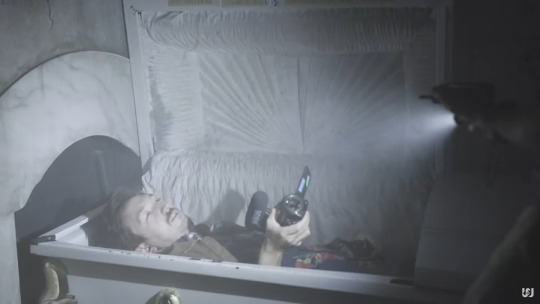Photo

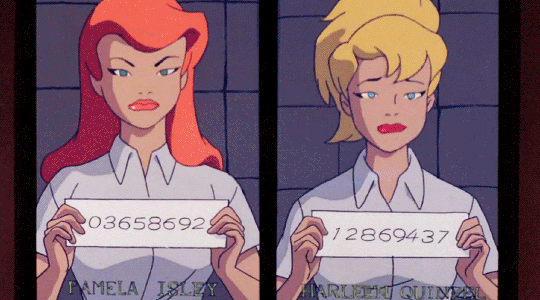
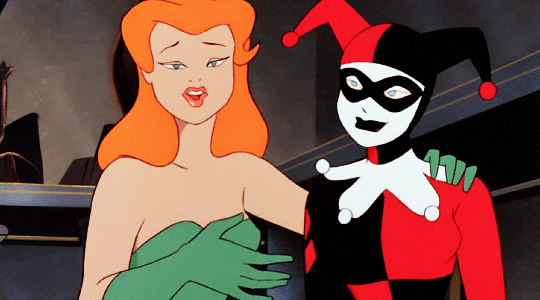
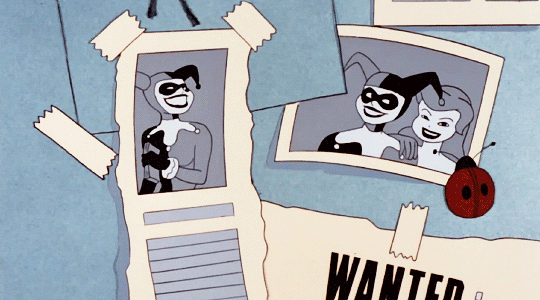
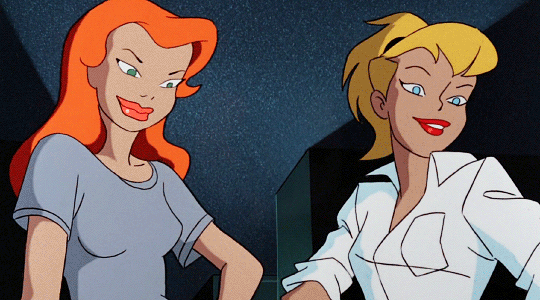
Batman: The Animated Series - Harley and Ivy
1K notes
·
View notes
Text
Zionists are upset like hell that Hamas released the Thai workers and the grandmothers. Hah

8K notes
·
View notes
Text

The #ConnectingGaza campaign supplies E-Sims to people on the ground in Gaza, allowing them to circumvent internet disruption/blackout during the siege and continue connecting with the wider internet. A digital SIM card (called an e-SIMs) works the same as a physical SIM Card, providing data and SMS for a phone number. E-Sims are one of few resources that can be directly accessed without blockage by people on the ground in Gaza.
Artists will be offering art in exchange of the value of the donated e-SIMs. Visit https://cartoonist.coop/esims4gaza to learn more.
16K notes
·
View notes
Text
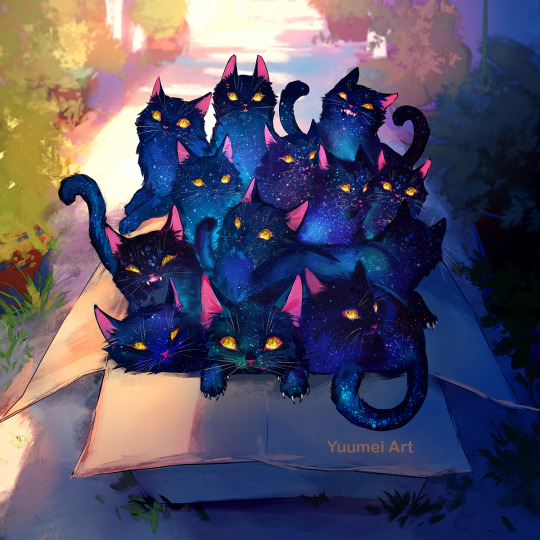
Box of Space⭐✨🌟
I would bring the whole box home, consequences be damned.
25K notes
·
View notes
Text


ଘ(੭ˊ꒳ˋ)੭✧ for @heartwyrm
191 notes
·
View notes
Text

219 notes
·
View notes
Text
Thoughts on Barbie - Feminism, Power Fantasies, Isekai, & Existentialism - SPOILERS!
I really like how the feminism in Barbie is actually kept simplistic. I don’t think the feminism in it needs to be super layered to make for an excellent and engaging movie, especially due to how Barbie the Movie, itself, is structured.
Of course the feminism presented in it is rather simplistic in nature. This makes sense since this is Stereotypical Barbie’s first exposure to feminist ideology and thoughts. She was a doll with a very childlike understanding of how the world works and functions. This also makes sense, since the Barbies in general are all toys geared at young girls. Their world is a reflection of the fluffy promises and hopes that we, as adults, feed to young children (especially girls). This idea that they can be anything and do anything.
But the reality is much more messy and complicated than that. We see the Barbies (and Kens) beginning to understand this towards the end of the movie - after they have all been “touched” by the Real World. They have engaged with Gloria and Sasha and the CEO of Mattel and so on and so forth. There is now no instant change in ideology (like what we see happen when Ken brings over patriarchy to Barbie Land), instead, we see the sort of social change that happens in the Real World - slow moving and made in small intervals. But, at the same time, we see Stereotypical Barbie and Ken working through more complex ideas and emotions surrounding feminist thoughts and ideologies.
I also feel like it was less the feminism itself that makes the movie stand out in a way, but the way they present it. They don’t hide it behind a dark and grim story, they don’t have it being presented just generally to the audience or subtlety hinted at - instead the movie is bright and colorful and silly - and we have two older women (Gloria and Ruth) guiding younger women (Sasha and the Barbies) through the ups and downs of womanhood. Right, Sasha is a teen girl in the Real World who is starting to understand more and more of life’s complexities, but still missing some of the time and experience that can add more nuance and understanding to many areas of life. While Barbie is like a young adult woman - a college girl that is just getting ready to graduate and really head out into the actual Real World.
So it’s all about being able to relate (whether in a big way or a small way) to the shared experiences that are being depicted on the screen. It’s a movie created by a woman specifically for women (and yes, that includes trans women - the Youtuber, Kat Blaque, who is a trans woman, did a review of Barbie where she talked about the trans rep and how they got it right - I’ll link her video below). It is speaking directly to us women. All of us.
Which also gets me into thinking about power fantasies, isekai (and reverse isekai) a genre that is about “normal human ends up in a fantasy land,” with the reverse being that a fantasy being (usually of some high power or standing) ending up in the normal human world, and how men and women tend to play into these narratives.
Many power fantasties that we see tend to involve men - even the ones aimed at women - such as the take I’ve seen of how “teen girl x immortal (usually male) being” in YA novels is about girls seeing themselves in a place of emotional power over men. Superhero narratives are all about normal people gaining superhuman powers - usually in a way that makes them physically stronger - and these all tend to play into male power fantasies and gazes, even when the superhero is a woman. Even if they may touch on feminist ideologies, the way the power fantasy element is handled is still very different from what we see here in Barbie.
In Barbie, we follow Stereotypical Barbie. She is like that ordinary human. Nothing about her really stands out and she doesn’t have any amazing job. That being said, there are elements about her existence that we, as humans, would find to be almost superhuman or advantages over us - never aging, never dying, being able to float from the top of your house right into your car, etc. But, Stereotypical Barbie herself, like within her own world, doesn’t hold any kind of power or high standing. Her journey into the Real World is essentially a reverse isekai.
In the end, Barbie chooses to stay in the Real World and become a human. She chooses the more flawed existence over the more perfected one (or seemingly perfected one anyway). And I think it is the moments that touch on this aspect of Barbie’s journey which is what makes the movie so special to so many women. Not necessarily the Feminism 101 aspect, which is just an element to Barbie’s journey into womanhood. It’s Barbie seeing the elderly lady next to her on the bench and seeing the beauty in her. It is Barbie meeting Sasha and Gloria and learning from them about how hard life is for women in the Real World still. It is Barbie’s talks with Ruth. Quiet and introspective and filled with a soft patience that comes with age and life. And it is Barbie seeing and experiencing all of these things and then choosing to become human and live in the Real World.
Not because of men. Not because of romance. Not because of any sort of power fantasy that engages in a male gaze and perspective. But because of the women she has met in the Real World. The connections she made with them and the hopes, dreams, and feelings of all girls and women in the Real World.
That’s the moment that makes Barbie so special. That’s the moment that really makes everyone in the theater feel connected, especially the other women and girls present there. That moment is what made the movie for me. The culmination of Barbie’s exploration of existentialists ideologies through a purposefully and specifically woman focused lens.
62 notes
·
View notes
Text
hey yall,
I know I haven’t posted in a LONG time. I really appreciated the anti sessrin community on here and that was the main thing that I engaged with for a while. Lately I’ve been focusing on my career and crafting/making cute decoden products! This brings me joy. That being said, I recently was browsing the boxlunch website and saw a coinpurse that had sesshomaru and yes, RIN. CHILD RIN. This sequel just won’t die and they keep trying to make profit from people’s nostalgia from Inuyasha OG series. It makes me really sick, and no I won’t share the link. I just wish I could exist in a world where I literally never have to see pictures of Sesshomaru/Rin together, it’s disturbing. They can acknowledge that the pair met when she was a child but that’s as far as the thinking goes. ugh.
Anyways, I hope everyone is well! sending love
36 notes
·
View notes
Photo
These kids are superior to those twins in the show that shall not be named ❤️🙏
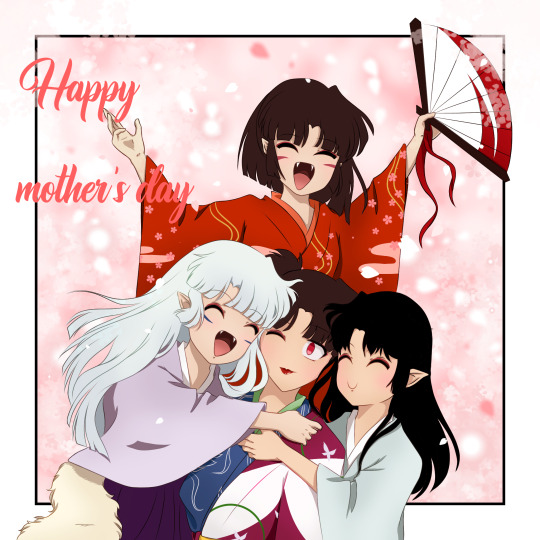
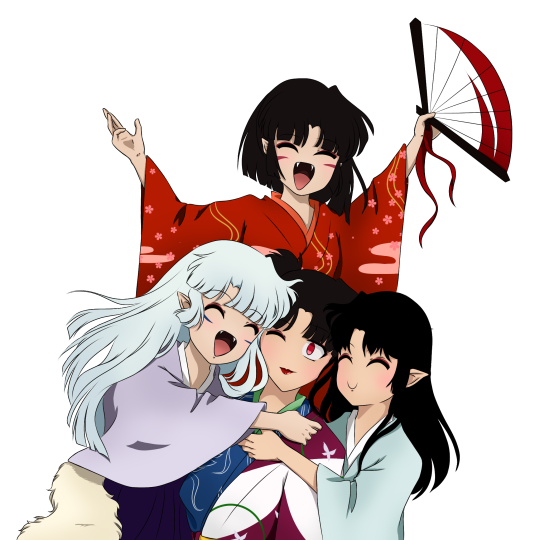
Happy mother’s day
59 notes
·
View notes
Photo

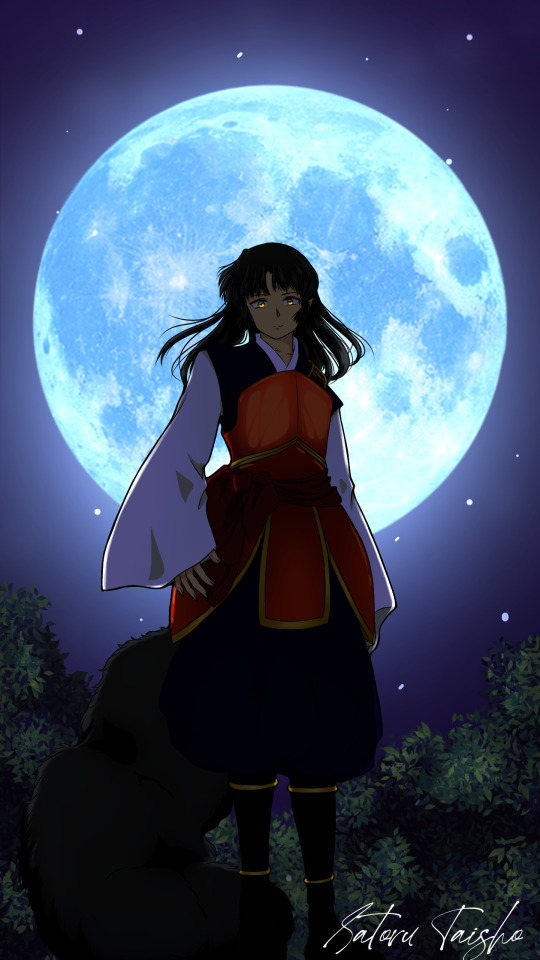
25 notes
·
View notes
Photo
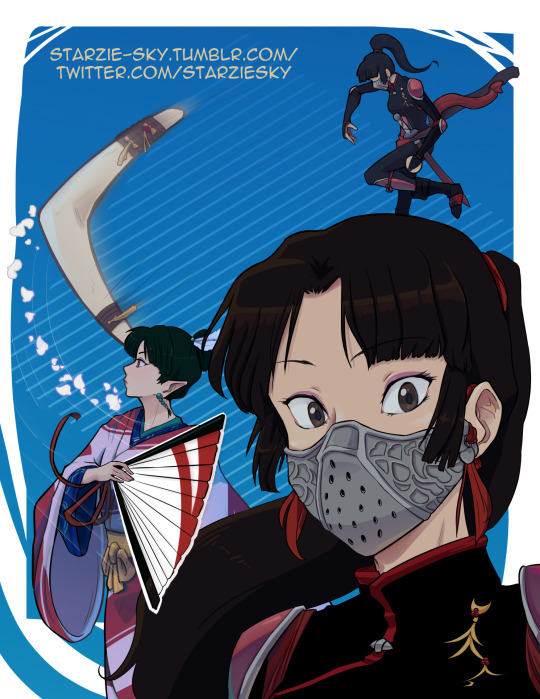

Demon and The Slayer 🌺🌸🐚
Inspired by a few headcanons from @sangosheart
#honestly#it makes sense#i would support this and miroku with kikyou lol#sango#kagura#kagusan#i love them
295 notes
·
View notes
Text
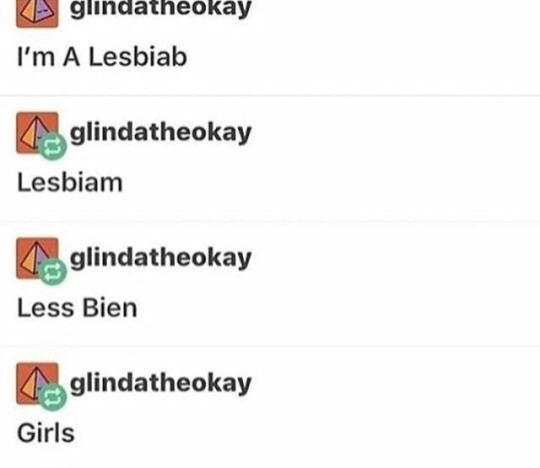


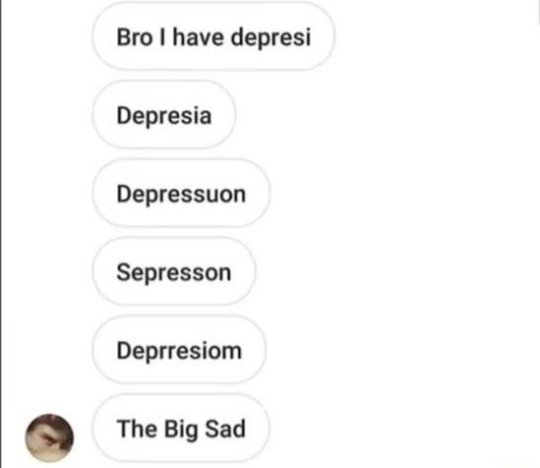





this is the true essence of parallelism
110K notes
·
View notes
Text
When Inuyasha Betrayed Kikyō
Today, I’m going to write about the most divisive character in the fandom: Kikyō. To make matters worse for myself, I’m going to point out when Inuyasha, a far less controversial character, hurt her.
To be honest, I almost didn’t write this article, because I feared a flood of hatemail in the askbox. I’ve read posts calling Kikyō everything from “Rumiko’s precious Mary Sue” (what?) to “Kinkyho” (the most imaginative but least mature of insults).
To be fair, most Western fans of Inuyasha were introduced to Kikyō through the anime, where Kikyō fell victim to Sunrise’s character assassination. As an example, here’s what ends Kikyō and Inuyasha’s hug in chapter 173:
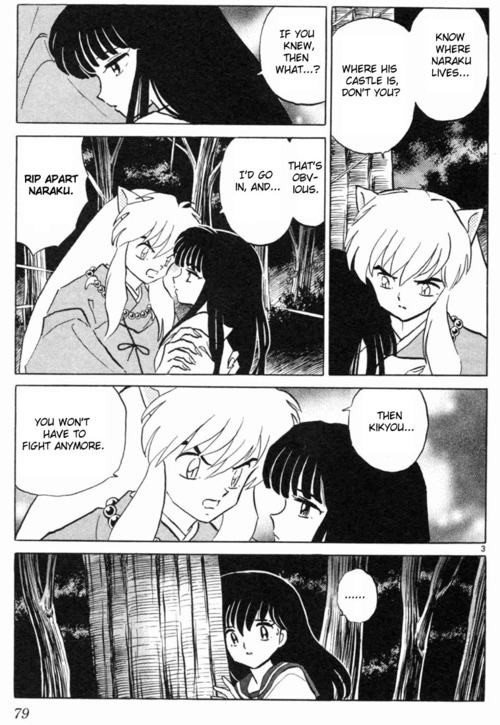
Here’s what ends their hug in the equivalent episode, Onigumo’s Heart Still Beats Within Naraku:
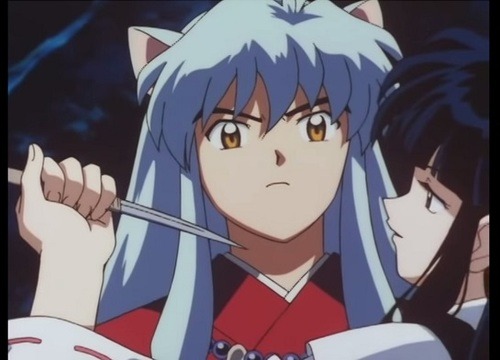
Quite a difference between Inuyasha professing his desire to protect Kikyō and Kikyō holding a knife to Inuyasha’s throat.
Now, Kikyō does do terrible things. She attempts to kill Kagome, she empowers Naraku, she takes advantage of Kohaku’s guilt. Kikyō’s indirectly responsible for every death caused by Kanna, Kagura, Goshinki,Hakudoshi, Byakuya, and the rest—all because she wanted to defeat Naraku. Even if his defeat came at the expense of everything and everyone else.
But one time, Kikyō did what she had to do, at Inuyasha’s expense, and was thoroughly justified.
I’m talking about when she pinned Inuyasha to the Goshinboku with a sacred arrow.
Let’s take a look at the original manga pages, in the original watercolors:


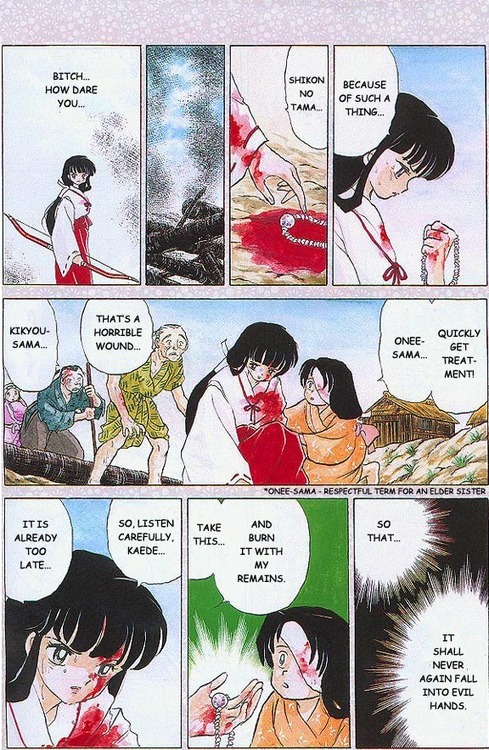
Kikyō’s gotten a lot of criticism for “So that…it shall never again fall into evil hands.” Inuyasha stole the Shikon no Tama because Naraku tricked him. There’s no way Inuyasha could be described as evil, right?
Look at what Inuyasha’s doing. That isn’t Naraku or one of Naraku’s puppets. That is the real Inuyasha rampaging through Kikyō’s village after stealing the Shikon no Tama. Sunrise would have you believe Kikyō’s responsible for Kaede’s missing eye, but as you can see, there’s fresh blood leaking through Kaede’s bandage. Kaede lost her eye because of Inuyasha’s attack.
Inuyasha’s not even fighting Kikyō here. Instead, he’s taking his anger out on the helpless and innocent villagers she protected.
When Kikyō dragged herself back to the village, she found Inuyasha attacking her people while running away with the Shikon no Tama. It didn’t matter if she trusted or loved him. The real Inuyasha was really hurting her people and her little sister.
In life, Kikyō never betrayed Inuyasha. Inuyasha, however, betrayed Kikyō. Every time Kikyō sees Inuyasha after her resurrection, she sees the man who stole the Shikon no Tama and attacked her village. Every time Inuyasha asks Kikyō to trust him to kill Naraku, Kikyō must think of what happened the last time she trusted him.
I dislike writing about Inuyasha this way, as he’s honestly my favorite out of the entire cast. I think he had the best character arc. Ignoring his worst actions, though, cheapens his growth as a character.
Ignoring Kikyō’s better qualities and her reasons for her actions also cheapens Inuyasha’s character. Instead of a man determined to atone for betraying someone he wanted to protect, he becomes a love-sick puppy who fails to see Kikyō doesn’t want him around.
Kikyō’s bad and good qualities are what make her so divisive. A fan portraying her as just a raging ex-girlfriend leaves her lifeless on the page. A lifeless Kikyō hurts the characterization of every character who interacts with her.
—tekka-wekka
557 notes
·
View notes


